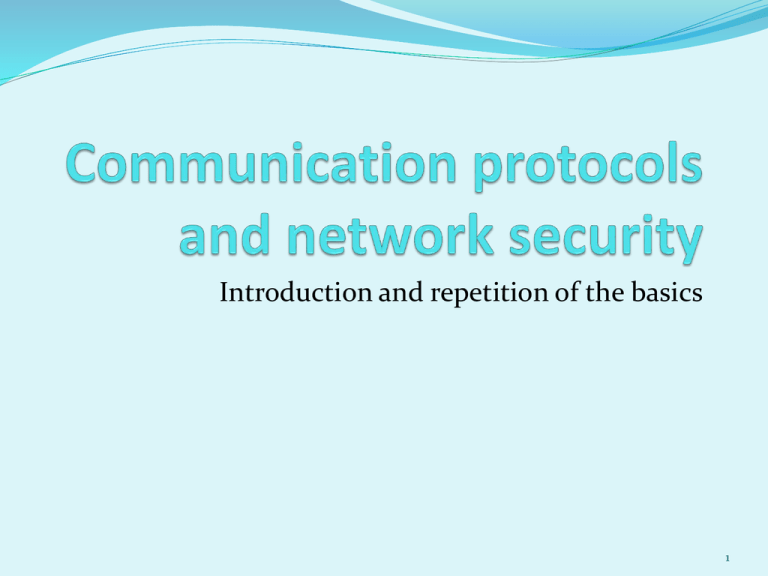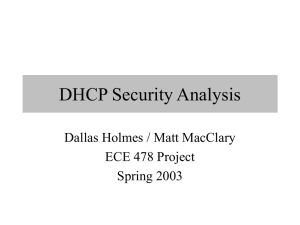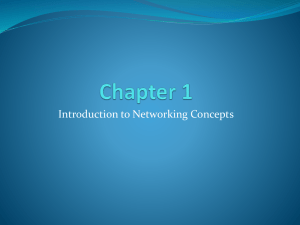Network layer
advertisement

Introduction and repetition of the basics 1 Communication protocols and network security Professor: dr. Andrej Brodnik (Ljubljana) Teaching Assistant: as. dr. Gašper Fele Žorž Implementation of course : 3 hours of lectures –consisting of two parts, 2 hours of lab work per week contact : e-mail, consultation hours, forum on the course web page 2 Content of the course Repetition of the basics of communications (ISO/OSI, TCP/IP, protocols, services, security), control and management of networks, distribution (multicasting), real-time applications, security: authentication, authorization, records, safe transfers, VPN, certification, firewalls, IDS systems, information for network operation, LDAP, IEEE 802. 3 Content of the course – an indicative plan week lecture HW 8.10. Introduction 1 15.10. Starting your computer, network configuration 1 22.10. Managment and control of the networks 1 29.10. Circulation and real-time aplications 2 5.11. Distribution 2 12.11. Distribution/Preparation for the test 2 19.11. MIDTERM TEST 1 26.11. Elements of network security 3 3.12. Authentication, authorization, records (AAA) 3 10.12. Authentication, authorization and records (AAA) / avtorizacija in beleženje (AAA) / Data for network operation (LDAP) 17.12. Visiting lecturer 24.12. <<< Christmas holidays >>> 31. 12. <<< Christmas holidays >>> 7.1. Družina IEEE 802 14.1. MIDTERM TEST 2 SEM SEM1 3, 4 4 SEM2 4 Obligations Final grade(≥50): 4 pieces of homework: 2 seminar papers: written exam or 2 midterm tests: 20% 40% 40% 100% Obligations : notes : 2 x per lecture, 1x laboratory work homework≥ 40, each homework ≥ 20 seminar paper ≥ 40, each seminar paper ≥ 20 written exam ≥ 50, each of the midterm tests≥ 40 5 Obligations The grade also takes into account: participation in the forums Complementing the notes assistance to the colleagues ... 6 Literature J. F. Kurose, K. W. Ross: Computer Networking, 5th edition, Addison-Wesley, 2010. A. Farrel: The Internet and Its Protocols: A Comparative Approach, Morgan Kaufmann, 2004. E. Cole: Network Security Bible, Wiley, 2nd edition, 2009. Mani Subramanian: Network Management: An introduction to principles and practice, Addison Wesley Longman, 2000 RFC … 7 8 ISO/OSI model The model consists of seven layers, which define the layers of related functions of the communication system. Application layer Presentation layer Session layer Transport layer Network layer Data link layer Physical layer 9 ISO/OSI model layer N provides services (serving) for layer N +1 layer N requires services (deliverability) from layer N-1, Protocol: rules of communication between processes on the same location, Entity pair: pair of processes that communicate on the same layer layers N N-1 . . . 2 1 System A System B Application layer Application layer Presentation layer Presentation layer Session layer Transport layer Entity pair of processes Session layer Transport layer Network layer Network layer Data link layer Data link layer Physical layer Physical layer ->Direction of communication -> 10 Analogy : conversation between two philosophers Why layers? systematic concept of system architecture, The change of implementation of one part of the system is independent from the rest of the system. 11 ISO/OSI model In other words: Each layer has its own protocols(the language used for communication by the processes on the same layer) The protocols are specific for the services provided by the layer 12 OSI layers: detailed closest to the user, Allows application interaction with network services. standard services : telnet, FTP, SMTP, SNMP, HTTP 13 OSI layers Determines the meaning of the data between the entity pair of the application layer, syntax and semantics, provides coding, data compression, security mechanisms controls conversations between applications, logical connection between applications, usually it's built into the applications. 14 OSI layers (unit: SEGMENT) effective, reliable and transparent data transfer between users; Provide these services to higher layers, Mechanisms: control of the flux, segmentation, control of the errors., Connection and connectionless oriented transfers, TCP, UDP, IPSec, GRE, L2TP, PPP 15 OSI layers (unit: PACKAGE) routing(Connection and connectionless oriented services) transmission of packages from the source to the target computer, can provide : guaranteed delivery, correct sequence, fragmentation, avoiding of clogging, routing, r outers, routing algorithms, protocols : IP, ICMP, IPSec, IGMP, IPX 16 OSI layers (unit: FRAME) asynchronous / synchronous comunication, physical addressing : MAC address, detection and debugging of errors(parity, CRC, checksum) Control of the flux, framing protocols : Ethernet, PPP, Frame Relay 17 OSI layers transmission of bits through the channels(copper/optics/wireless), digital, analog media, UTP, optics, coaxial cables, wireless networks, RS-232, T1, E1, 802.11b/g, USB, Bluetooth 18 OSI model and model TCP/IP Comparison of models : ISO OSI: de iure, theoretical, systematic, lack of implementations(products), TCP/IP: de facto, adjustable, unsystematic, many products 19 E ncapsulation message segment M Ht M datagram M frame Hn Ht Hl Hn Ht M M Ht M Hn Ht Hl Hn Ht M M application transport network data link physical application transport network Data link physical data link physical Hn Ht M Hl Hn Ht M network data link physical switch Hn Ht M router 20 21 Network layer: Network layer functions transportna layer: TCP, UDP network layer functions Protocol IP •addressing •Shape of datagrams •working with packages routing •Choice of the root •RIP, OSPF, BGP Intermediary table Protokol ICMP •signaling errors •additional notices Data link layer Physical layer 22 Network layer: Routers Use of routing protocols (RIP, OSPF, BGP) forwarding datagrams between the input and output ports 23 Network layer: Comparison of active equipment device that works on the NETWORK layer maintains arp tables, perform directional algorithms Device that works on DATA LINK layer, maintains the switching table, perform filtration and network detection device that operates at the PHYSICALlayer, it is no longer in use 24 Network layer: IPv4 Protocol on network (3.) layer OSI model is 32-bit address interface. Example : 11000001 00000010 00000001 01000010 or 193.2.1.66 is a crowd of IP addresses that are accessible among each other without the intercession of the router. Mask (32 bits) provides part of the IP address that represents the subnet address. example: 11111111 11111111 11110000 00000000 (255.255.255.240) means that the first 20 bits of the IP address represents the network address and the remaining 12 bits are address of the 25 interface. Network layer: Exercise! The IP address of some interface and mask of the subnetwork are given 193.90.230.25 /20 What is the address of the subnetwork? What is address of interface? 26 Network layer: IPv6 : larger address space : 128 bites Quick direction and intercession and QoS is enabled by the format of the head, there is no fragmentation, The implementation of IPSec within IPv6 is obligatory : consisting of 64 bits for the subnet ID + 64 bites for interface ID 0010000111011010 0000000011010011 0000000000000000 0010111100111011 0000001010101010 0000000011111111 1111111000101000 1001110001011010 Written hexadecimal, separated by colons 21DA:00D3:0000:0000:02AA:00FF:FE28:9C5A 21DA:D3:0:0:2AA:FF:FE28:9C5A or(without leading zeros) or(omit blocks of zeros) 21DA:D3::2AA:FF:FE28:9C5A 27 Network layer: Comparison of IPv4 and IPv6 28 Network layer: IPv6 - types of addressing addressing each network interface addressing of a group of network interfaces, delivery to all interfaces in the crowd is the address of the crowd of the interfaces, the delivery is performed to one of the interfaces of the crowd(the closest one?) Each interface can have multiple addresses of various types.(BROADCAST addresses – in IPv6 they ore no longer there!) 29 Network layer: IPv6 - types of unicast addresses 1.) 2.) 3.) (= public addresses) (localhost ::1, undefined 0::0, IPv4 addresses) (within 1 connection, adhoc network) FE80::/64 4.) (Private addresses, within the org. they are not performed, FEC0::/10) 5.) (private addresses, allocated by the registrar, they're better 30 structured, FC00::/7) Network layer: IPv6 – distribution (multicast) 1.) FF02::1 (link local: all interfaces) 2.) FF02::2 (link local all routers) 3.) address structure : 31 Network layer: IPv6 in IPv4 networks 1.) 2.) routers known IPv4 and IPv6 IPv6 packet packed in one or more IPv4 packets as data. 32 Network layer: Routing static / dynamic (consideration of conditions in the network) centralized / distributed(according to the knowledge of the whole network status) one way / by multiple pathways With the distance vector(RIP, IGRP, EIGRP) according to the network status(OSPF, IS-IS) 33 Transport layer: Functionalities : Receiving a message from application Assembling segments in the message to the network layer Transferring to application layer interface between the transport and application layer, We address the process with the IP number and the port number (www: 80, SMTP: 25, DNS: 53, POP3: 110). process process plug socket connection Internet connection 34 Transport layer: Connection and connectionless oriented TCP and UDP, and other protocols establishment, transmission, demolition – connection in the protocol(TCP) in the application(UDP) directly(ACK and NACK) indirectly(only ACK, we conclude according to the number of packages) Simultaneous confirmation: the next package is sent only after the receival of the confirmation Fluent sending: no waiting for the confirmation 35 Transport layer: TCP and UDP 36 Application layer: telnet, ssh; rdesktop ftp, sftp WWW in HTTP, SMTP, POP3, IMAP, MAPI DNS, SNMP, LDAP, RADIUS, ... ... 37 Application layer: Communication of two random final systems servers are not constantly switched on, broken connections/ changes to IP addresses, examples: BitTorrent, Skype 38 Network and transport layer: From the past to the future : lack of IPv4 addresses The efficiency of private address spaces NAT gateways - usually at the same time firewalls too simply in client-server systems In P2P we need a copy address in the outer world In IPv6 NAT gateways are not required 39 40 Example of communication: Web browsing browser Internet provider 68.80.0.0/13 DNS server faculty network 68.80.2.0/24 Web page Web server 64.233.169.105 Google network 64.233.160.0/19 41 Example of communication: Web browsing When it connects to the DHCP DHCP DHCP DHCP DHCP UDP IP Eth Phy network, the laptop needs an IP address, and the data of connection and DNS server: It uses DHCP. The request DHCP encapsulates: UDP -> IP -> 802.1 Ethernet DHCP DHCP DHCP DHCP DHCP UDP IP Eth Phy ethernet frame router (uses DHCP) transmits(broadcast) itself to the network , it is received by the router, which carries out the DHCP server's task DHCP server reads the content of DHCP request 42 Example of communication: Web browsing DHCP answers to the client DHCP DHCP DHCP DHCP DHCP UDP IP Eth Phy (laptop) with the DHCO ACK package, which contains its IP address and the addresses of the transition and DNS server The answer encapsulates the DHCP DHCP DHCP DHCP DHCP UDP IP Eth Phy DHCP server (router) and passes it on to the clienet which decapsulates. The DHCP client receives the router (uses DHCP) answer DHCP ACK The result: The client is ready for communication 43 Example of communication: Web browsing Before sending off the http request DNS DNS DNS ARP query DNS UDP IP Eth Phy ARP reply Eth Phy we need the IP of the server www.google.com: use DNS Encapsulation of the DNS request: UDP ->IP -> Ethernet. We need MAC address of the router: use ARP We send off the ARP request, the router answers with the ARP answer, which keeps its MAC address The client now knows the MAC address of the gateway, which can send the DNS request to it. 44 Example of communication: Web browsing The IP datagram with is passed on the router. IP datagram is passed on the , which is in the network of internet provider (RIP, OSPF, IS-IS ali BGP), DNS server the request and sends to user the IP address of the network server www.gooogle.com DNS DNS DNS DNS DNS DNS DNS UDP IP Eth Phy DNS DNS DNS UDP IP Eth Phy DNS server DNS network provider 45 Example of communication: Internet browsing HTTP SYNACK SYN SYNACK SYN SYNACK SYN To send the HTTP TCP IP Eth Phy to the client first addresses the of the web server routing.... SYNACK SYN SYNACK SYN SYNACK SYN TCP IP Eth Phy Web server , segment direct itself through the network to the web server The web server answers with (confirmation of the handshake), The TCP connection is now established! 46 Example of communication: Internet browsing HTTP HTTP HTTP HTTP HTTP HTTP HTTP TCP IP Eth Phy is sent to the of the web server, , which contains the internet request for the website www.google.com is directed to the web server The internet server answers routing.... HTTP HTTP HTTP HTTP TCP IP Eth Phy with , which contains the contents of the webpage The IP datagram with the webpage is directed to the client, Web server 47 Capturing data from the network 48 Capturing data from the network: DHCP example Message type: Boot Request (1) Hardware type: Ethernet Hardware address length: 6 Hops: 0 Transaction ID: 0x6b3a11b7 Seconds elapsed: 0 Bootp flags: 0x0000 (Unicast) Client IP address: 0.0.0.0 (0.0.0.0) Your (client) IP address: 0.0.0.0 (0.0.0.0) Next server IP address: 0.0.0.0 (0.0.0.0) Relay agent IP address: 0.0.0.0 (0.0.0.0) Client MAC address: Wistron_23:68:8a (00:16:d3:23:68:8a) Server host name not given Boot file name not given Magic cookie: (OK) Option: (t=53,l=1) DHCP Message Type = DHCP Request Option: (61) Client identifier Length: 7; Value: 010016D323688A; Hardware type: Ethernet Client MAC address: Wistron_23:68:8a (00:16:d3:23:68:8a) Option: (t=50,l=4) Requested IP Address = 192.168.1.101 Option: (t=12,l=5) Host Name = "nomad" Option: (55) Parameter Request List Length: 11; Value: 010F03062C2E2F1F21F92B 1 = Subnet Mask; 15 = Domain Name 3 = Router; 6 = Domain Name Server 44 = NetBIOS over TCP/IP Name Server …… Message type: Boot Reply (2) Hardware type: Ethernet Hardware address length: 6 Hops: 0 Transaction ID: 0x6b3a11b7 Seconds elapsed: 0 Bootp flags: 0x0000 (Unicast) Client IP address: 192.168.1.101 (192.168.1.101) Your (client) IP address: 0.0.0.0 (0.0.0.0) Next server IP address: 192.168.1.1 (192.168.1.1) Relay agent IP address: 0.0.0.0 (0.0.0.0) Client MAC address: Wistron_23:68:8a (00:16:d3:23:68:8a) Server host name not given Boot file name not given Magic cookie: (OK) Option: (t=53,l=1) DHCP Message Type = DHCP ACK Option: (t=54,l=4) Server Identifier = 192.168.1.1 Option: (t=1,l=4) Subnet Mask = 255.255.255.0 Option: (t=3,l=4) Router = 192.168.1.1 Option: (6) Domain Name Server Length: 12; Value: 445747E2445749F244574092; IP Address: 68.87.71.226; IP Address: 68.87.73.242; IP Address: 68.87.64.146 Option: (t=15,l=20) Domain Name = "hsd1.ma.comcast.net." 49 50 Network security analyzes the potential attacks on systems, Plans the techniques of the defence from the attacks, Forms safe architectures, which are resistant to the invasions First the vission of the internet was: “This was a group of people, thet trust each other and are connected to a common network” At the making of the protocol, the manufacturers made it with the methodology of ,, patching’’, The safety mechanisms should be considered at all layers of OSI model 51 How can the intruder harms the system? intercepting of messages, Active of messages in some communication, impersonization forges the original address or any other content of the package removes the real sender or receiver from the communication and takes-up his role Disables the use of the regular service (ex. With overloading it) 52 Security: ensure the reliability CONTROL: collect data of operation, use, diaries DISPERSION OF PROTECTIONE: integrity of connections, resources, content, users, messages PLANNING: performance, development, testing and deployment MANAGEMENT: action based on the collected data, diagnostics, administration SYSTEMATIC: directories, lists and indexes, SNMP, business rules 53 Elements of safe communication: – who is allowd to read? (encryption) – prove that it is really you (identification, tell who you are, without proof) – prevention of illegitimate use of sources (authorization – finding out if you can do something, accounting – who used what) – was it changed during the transmission? (nonrepudiation) you really sent/received it Practice showed: firewalls, intrusion detection systems, Safety on application, transport, network and data link layer 54 Authentication We make sure of the true identity of the person – co-speaker. APPROACHES : Challenge-response, We trust the third side, Authentication with the system of public keys 55 Confidentiality of messages: crypting (concealing) the content This is a form of defence from passive intruders (eavesdroppers) and active intruders (forgers). We encrypt message P with the E key – we get cryptogram E(P). We process the cryptogram E(P) into the original for with the D() key and what we get is original message D(E(P))-P. Different methods:: Substitution (change of symbols) / transposition (sequence of the symbols) Symmetric ( , ex. DES, AES) / asymmetric( ECC) , ex. RSA, 56 Types of cryptography Cryptography that uses keys: Algorithm is usually known to everybody, Only the keys are secretive encryption : hiding the content Crypto-analysis(,,crashing’’ of the code) Cryptography with public key E() ≠ D(): two keys– public and private Symmetric cryptography E() = D(): onlyone key Thickening functions – they are not cryptography. Don’t use keys. How can they be useful? 57 Cryptography with public keys is a system that defines the production, management, distribution, saving and cancelling of digital certificates. Users are authenticated with the help of public keys, which are certified by the certificate authority – CA) 58 Cryptography with public keys The algorithms for encrypting with public keys are asymmetric, E=encryption key, D=decryption key Key E and D must satisfy the following requirements encryption of message S : 2. 3. From known E and E(S) it must be impossible to figure out D From E it must be very hard / impossible to figure out D The most known algorithm is RSA(Rivest, Shamir, Adelman). RSA uses big prime numbers to define D and E; the procedure of encrypting/decrypting is the same as calculating the mod of divide by the product of these two numbers. Problem: distribution of keys, slowness . 59 Cryptography with public keys Message S Encryption Algorithm Cryptogram EB(S) EB Branko’s public key EB DB Branko’s private key DB Decryption Readable message algorithm S = D (E (S)) B B 60 Why is RSA safe? Let’s say that we know the public key of some person (defined by a pair of numbers (n, e)). To figure out the private key we have to know the denominators of the number n. But searching the denominators of a large number is hard or impossible with current computational capacities. How to find big enough prime numbers? We carry out “guessing” for several times: we generate a large number and test it, if it is a prime number, To test the prime numbers there exist efficient algorithms. 61 Integrity : Proves who sent the message and that the message is read only by the real receiver. We encrypt the message S, which is sent by A to B EB(DA(S)) = XXX and decrypt: DB(XXX) = DB(EB(DA(S))) = DA(S); EA(DA(S)) = S : proves that the message (also not crypted!) hasn’t been changed. To achieve that we use thickening functions, which calculate the signature of the message SIG (S). We sign this value with the mechanism of electronic signing DA(sig(S)) = sss And we send SSS along with the (encrypted) original message xxx: (xxx, sss). The receiver decrypts XXX into S, recalculates the sig (S) and checks is SSS=sig(S) 62 Certificates System PKI includes cetification authorities, which issue, save and cancell the certificates. Certificates are defined by the standard X.509 (RFC 2459) The certificate contains: The name of the Issuer, The name of the person, the address, the domain name and other personal information, The owners public key, The digital signature(signed by the private key of the issuer) 63 Next time we move on! connect a computer to to the network boot your computer : protocols DHCP and BOOTP architecture server– client, protocol: operation, its functions, protocol trace 64







